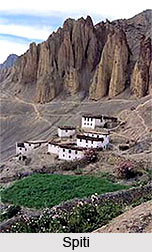 Spiti, which means the middle country, is a high altitude cold desert dotted with full of numerous monasteries. Rudyard Kipling in Kim called it a `world within a world` and a `place where the Gods live`. It lies in the rain shadow area of rugged mountain ranges of Zaskar and gets very little rain and plenty of snow. Alexander Cunningham in his book Ladakh explains the rainfall of Spiti as very scarce and rarely above four inches annually which seems to be falling on the same day.
Spiti, which means the middle country, is a high altitude cold desert dotted with full of numerous monasteries. Rudyard Kipling in Kim called it a `world within a world` and a `place where the Gods live`. It lies in the rain shadow area of rugged mountain ranges of Zaskar and gets very little rain and plenty of snow. Alexander Cunningham in his book Ladakh explains the rainfall of Spiti as very scarce and rarely above four inches annually which seems to be falling on the same day.
The whole valley seems to have been painted in hues of purple, pink and russet. The deep gorges carved out by the snow-fed streams add charm to Spiti"s stark splendour. The valley is locked between the Zaskar and the Great Himalayan ranges - the tallest ranges of Himachal. The Kunzum La - literally, meeting-place for Ibex (a kind of mountain goat) - is th tenuous link between Lahaul and Spiti. The Manali road traversing through Lahaul enters the valley through Kunzum La. This pass also connects Batal in the upper Chandra valley and the first village Losar of the Spiti valley. Kunzum La is crossable on foot from May/ June to October/ November and the snowfall here is also less than on the Rohtang pass. The Chandra River flows from the west of this pass and it also has a track that connects it to the enchanting Chandra Tal (4220m).
Spiti has four distinct regions and its main valleys are the Spiti Valley, Lingti Valley and the Pin Valley. Spiti, sub division of the Lahaul Spiti District is rougher in its terrain and is thus more difficult to traverse. The river valleys of Spiti still add some charm to the otherwise barren valley like the Spiti River that rises to the east of the Kunzum La.
The beauty of Spiti is visible only for four months. For the rest of the year it is hidden under a white veil of snow. Winters are usually spent in spinning and weaving cloth. Layers of woollen are worn by locals to trap body heat - in fact, even yaks and mules get their share of designer woollens.
Words about Spiti wouldn"t be complete unless the shales of Spiti are mentioned. The rockfaces found here are information banks on the geological history of the Himalaya while some of the valleys here are helpful in the study of creation of this lofty mountain range. Spiti shales or Ammonites are pretty well known in the field of geology. These were once living creatures that got extinct almost a hundred million years ago. They are now in the form of fossils. The ammonites once lived under the sea and the tectonic thrust that formed these areas also fossilised them. The best among the lot is called Shaligram and is considered very rare and lucky.
Most of the mountains of Spiti are still unclaimed by the mountaineers. Spiti thus invites scores of climbers as well as trekkers to come and rediscover her unconquered terrain where the Indian and Tibetan culture has mixed with each other.
Getting There
Direct bus service is available from Shimla and Manali. There is a bus service between Kaza and Shimla on every alternate day. There are one or two daily buses from/to Manali, but the bus service between Kaza and Keylong is not dependable. All the smaller places in Spiti can be toured by jeeps or taxis which can be hired from Kaza.



















